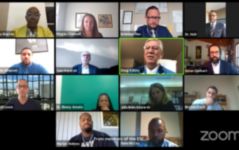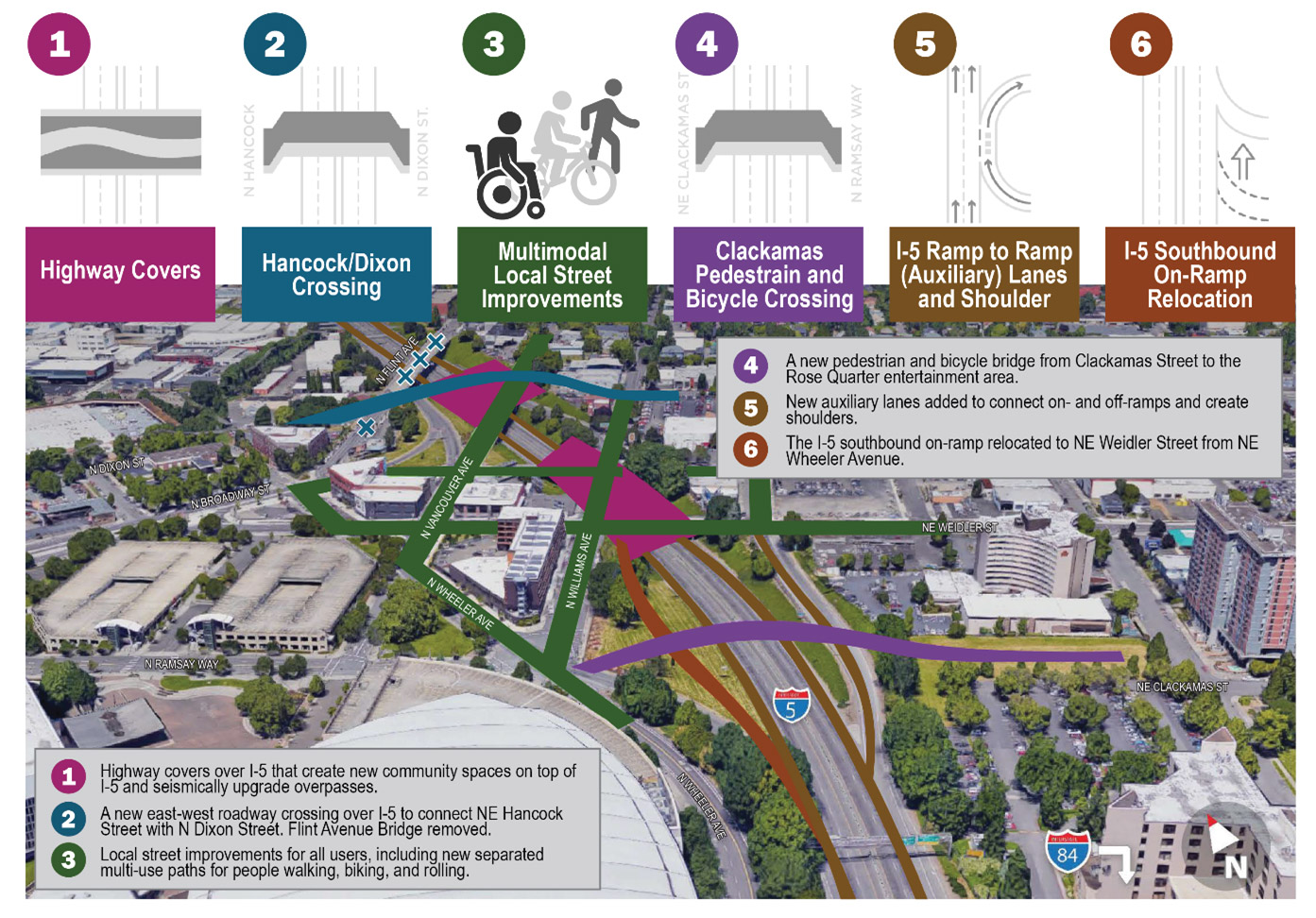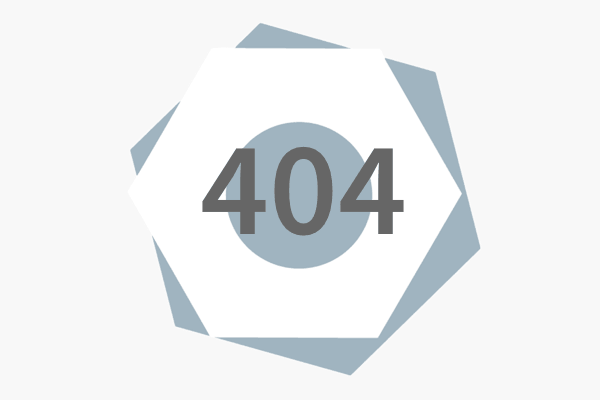Your feedback helps us
Your feedback, combined with work with our advisory committees, the Independent Cover Assessment, and ongoing conversations with our partners and stakeholders will help us understand community expectations, inform future design decisions, and ensure we deliver on our commitment to reconnect historic Albina. We want to build community relationships to develop a transformative project that reduces congestion, improves safety and re-establishes community connections that lead to economic opportunities, especially for our African American communities and neighbors.
Equity is at the center of our work
The Project and ODOT are committed to engaging and communicating with the community in a way that is equitable, intentional, culturally responsive, addresses barriers, and delivers information through trusted channels. The project team is committed to open and inclusive engagement and will be held accountable for doing so, specifically with the African American community and other communities of color.
We want to hear from you
What are your thoughts about the I-5 Rose Quarter Improvement Project at this early phase of design? Review the information in the following stations, then take our survey and share your ideas. The online open house and survey will be available through December 6.
Si desea obtener información sobre este proyecto traducida al español, sírvase llamar al 503-731-4128.
Nếu quý vị muốn thông tin về dự án này được dịch sang tiếng Việt, xin gọi 503-731-4128.
Если вы хотите чтобы информация об этом проекте была переведена на русский язык, пожалуйста, звоните по телефону 503-731-4128.
如果您想瞭解這個項目,我們有提供繁體中文翻譯,請致電:503-731-4128。
如果您想了解这个项目,我们有提供简体中文翻译,请致电:503-731-4128。
Stations
Project purpose
The project will transform the lower Albina neighborhood above I-5. It will reimagine highway overpasses to complement local street improvements that reconnect neighborhood streets. It will enhance public spaces while supporting opportunities for economic development and wealth generation for the Black community, including land redevelopment opportunities.
On I-5, the project will add auxiliary lanes and shoulders to improve travel reliability, predictability, and safety. It will reduce frequent crashes and smooth traffic flow between I-84 and I-405 where three interstates meet at the top traffic bottleneck in Oregon (and 19th-worst in the nation).
What are the project boundaries?
The following illustrates the project area and boundaries. This image shows potential highway cover space (green) that could be used in the future. We are committed to building highway covers that bridge both sides of the I-5 corridor in this area that provide new community space. Only after hearing how the community envisions the look and feel of the highway covers and the streets and sidewalks to which they connect, will the project once again connect sections of this historic neighborhood and provide economic growth and development opportunities.
(Swipe up and down to scroll; click to enlarge.)
What are the benefits of the project?
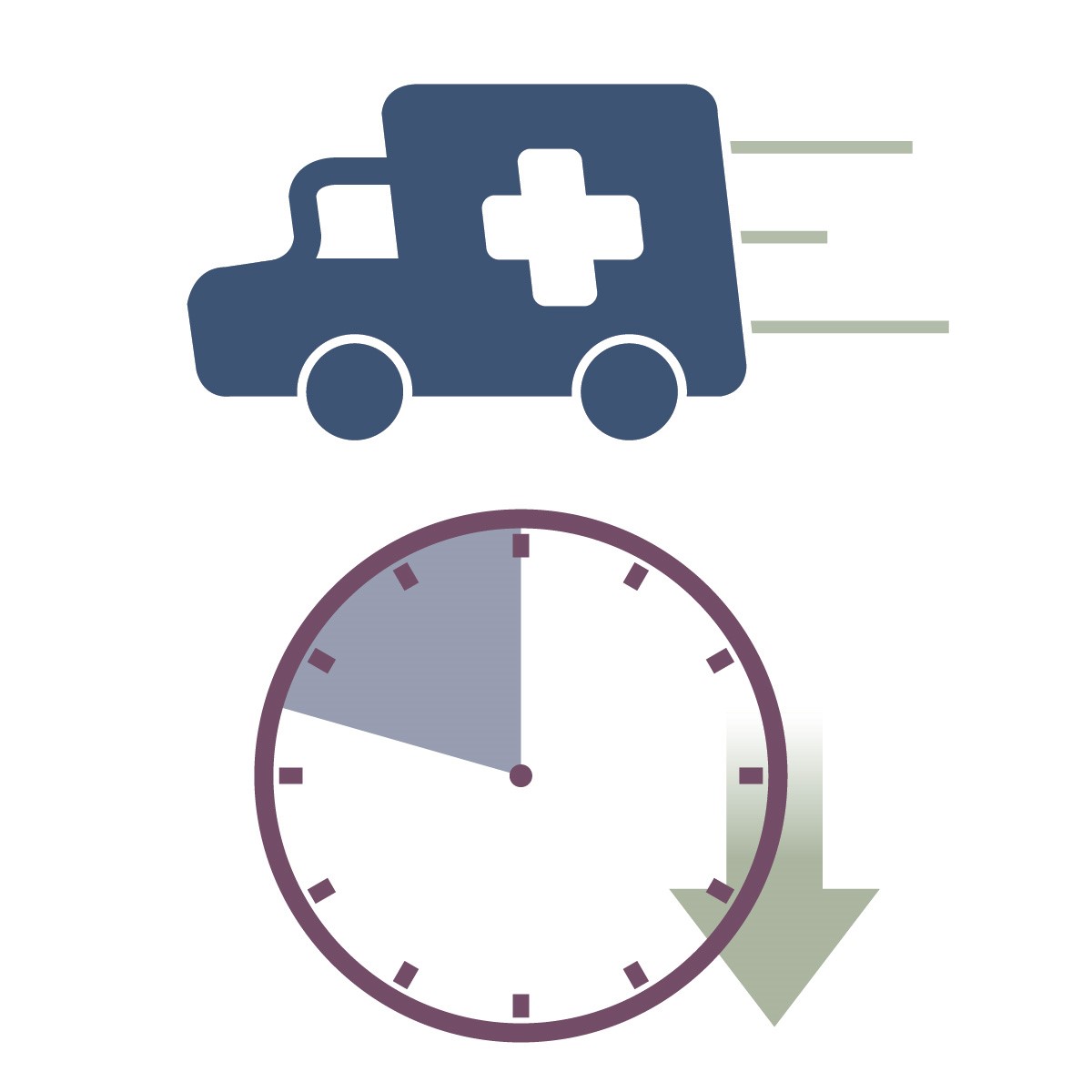
Auxiliary lanes and wider shoulders on I-5 will reduce crashes by up to 50% and improve congestion and travel flow, providing more reliable travel times and saving travelers 2.5 million hours of delay each year.
By providing new shoulders and continuous auxiliary lanes in both directions of I-5, the Project will reduce today’s awkward travel movements as drivers weave in and out of lanes. They also will provide areas for disabled vehicles to pull over or emergency responders to get around heavy traffic.
These improvements also pave the way for future “bus on shoulder” operations. Bus on shoulder is a strategy to improve bus service by allowing transit to use the highway shoulders. It removes buses from congestion and results in faster travel times and reliability.
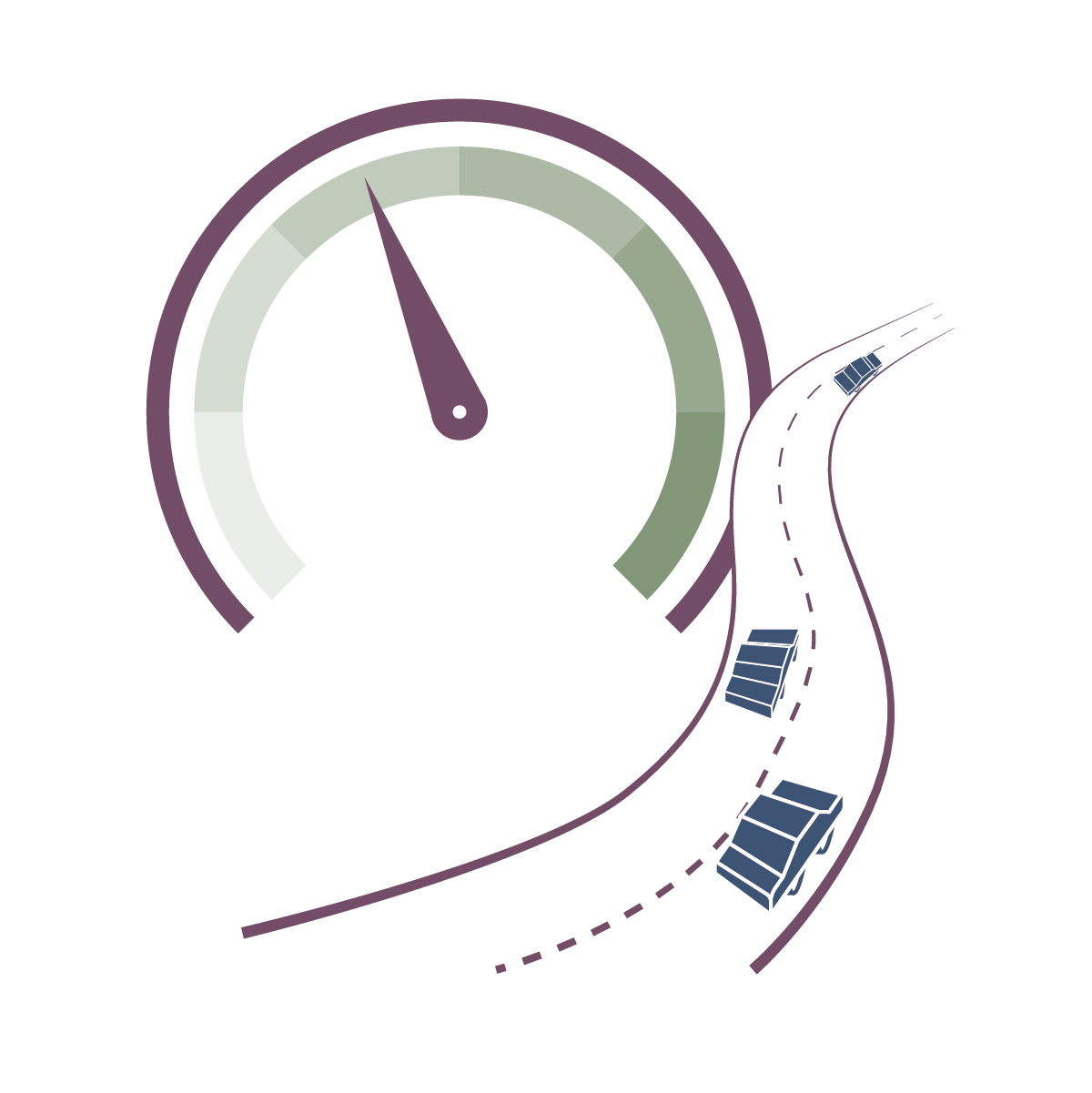
Project features will reduce the number of crashes and improve travel reliability for vehicles on I-5 and, in turn, vehicles on local streets affected by back-ups on the Interstate. This also benefits the movement of goods, such as Oregon’s exports and imports, from groceries to agricultural products to technology.
The section of I-5 between I-84 and I-405 has the highest crash rate of any Oregon urban interstate, is the worst bottleneck in the state and 19th worst freight bottleneck in the nation, and has substantial operational and navigational issues. There is traffic congestion on I-5 in the Rose Quarter area for 12 hours each day. Increased congestion and safety issues on I-5 between I-84 and I-405 means drivers experience delay and travel is less reliable for most of the day.

Together with agency and community partners, the project will support future economic development in the Albina community and support wealth generation through creating opportunities for partnerships around land redevelopment, workforce and business development, and other means.
We are committed to elevating the voices of the historically harmed Albina community to understand their needs of and provide benefit to this community. We will identify, encourage and facilitate opportunities for agency and community partnerships.
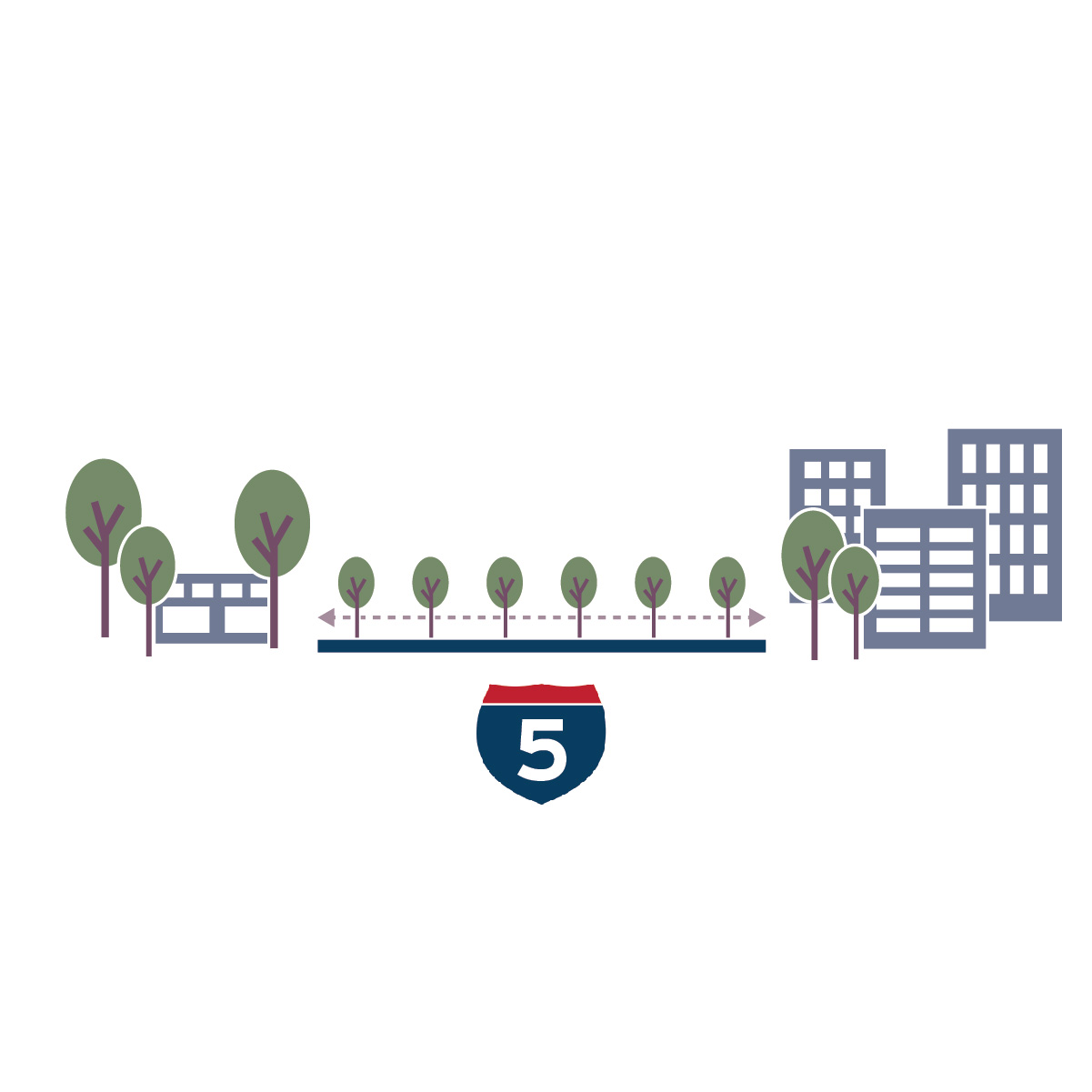
The Project will reconnect the community and support a sense of place and space consistent with local visions for transformation.
ODOT is committed to building highway covers that bridge both sides of I-5 and provide new community space. Using community feedback as a guide, the Project will re-connect sections of the historic Albina neighborhood and provide economic growth and development opportunities.
Our hope is that building highway covers will be a catalyst for us to work with other project partners to transform what exists today into a socially and economically inclusive community – one that is connected to the river and its surrounding neighborhoods.
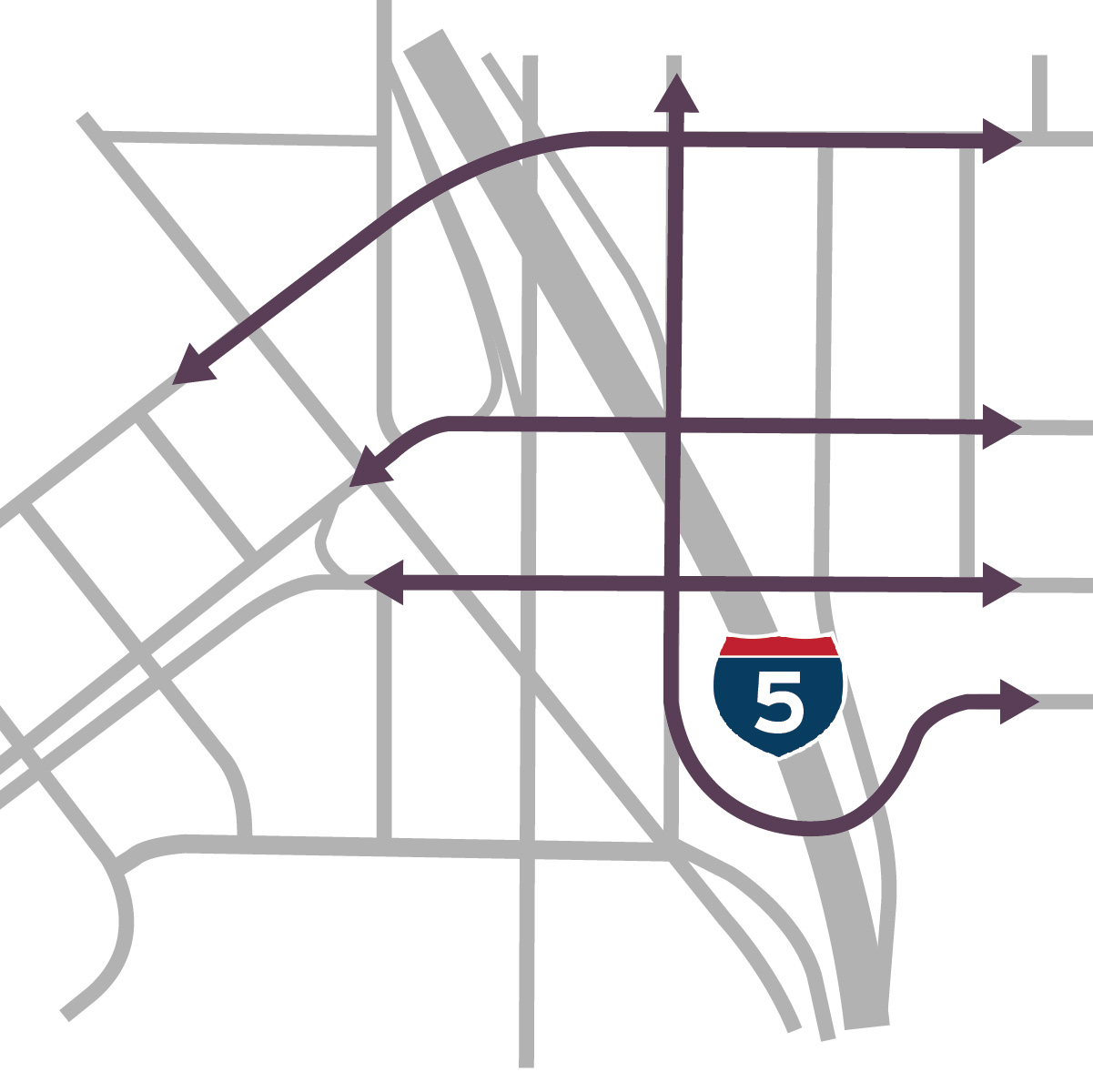
This project will provide approximately 8,500 feet of new or improved sidewalk/bike facilities that connect Albina and make it easier to cross I-5. Changes to the local street system will provide protected or separated sidewalks and bike lanes to create safe connections for people walking, rolling, bicycling, or riding transit in the Project area.
New highway overcrossings, such as the Clackamas Pedestrian and Bicycle Crossing, will provide additional options for people to comfortably cross I-5 where they cannot do so today, increasing options for people moving in and through Albina and the Rose Quarter.
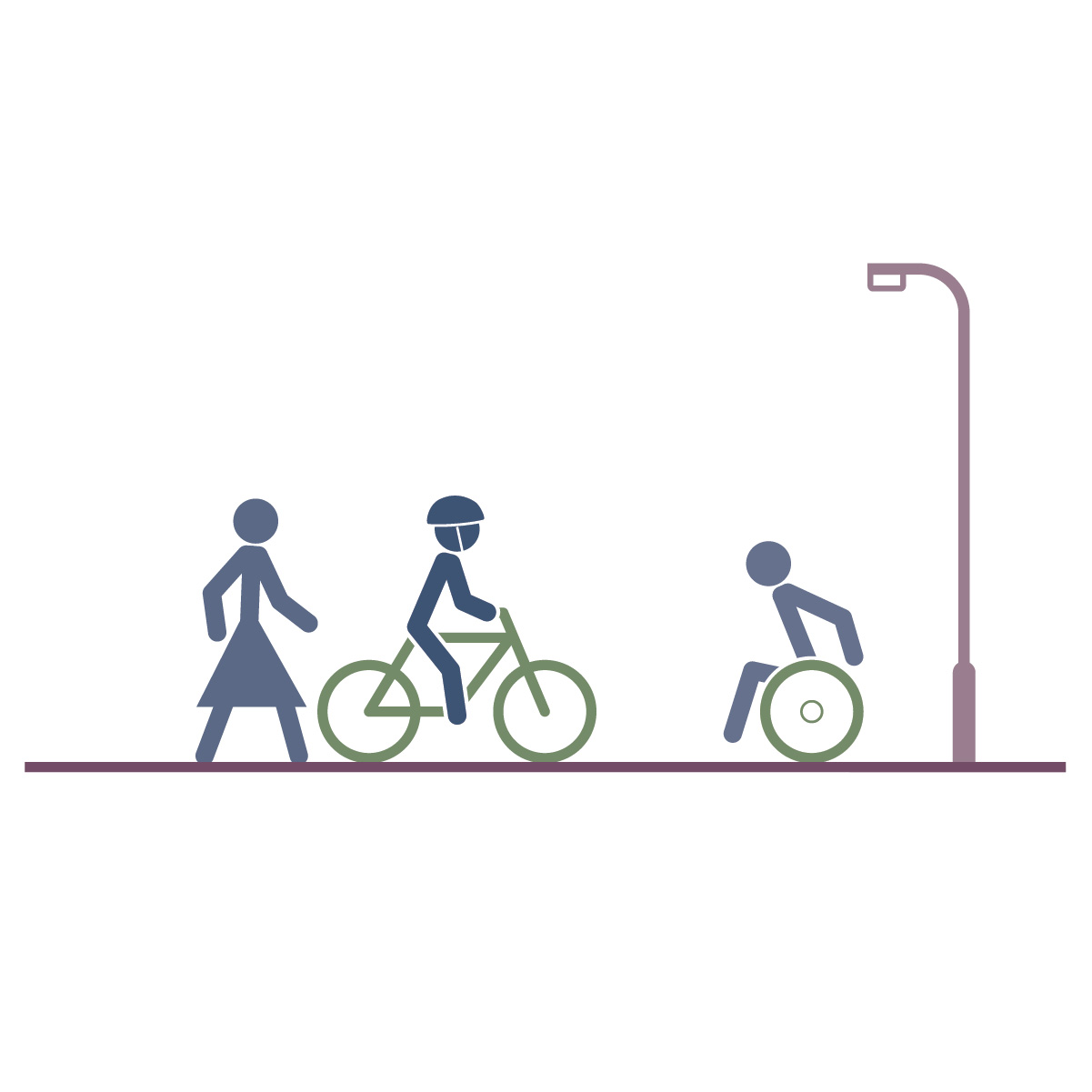
The Project’s local street changes will increase physical separation between automobiles and pedestrians and bicyclists.
The Project will include new widened and well-lit sidewalks, Americans with Disabilities-accessible ramps (ADA ramps), marked crosswalks, and widened bicycle facilities, all of which provide more comfortable and convenient access to local transit.
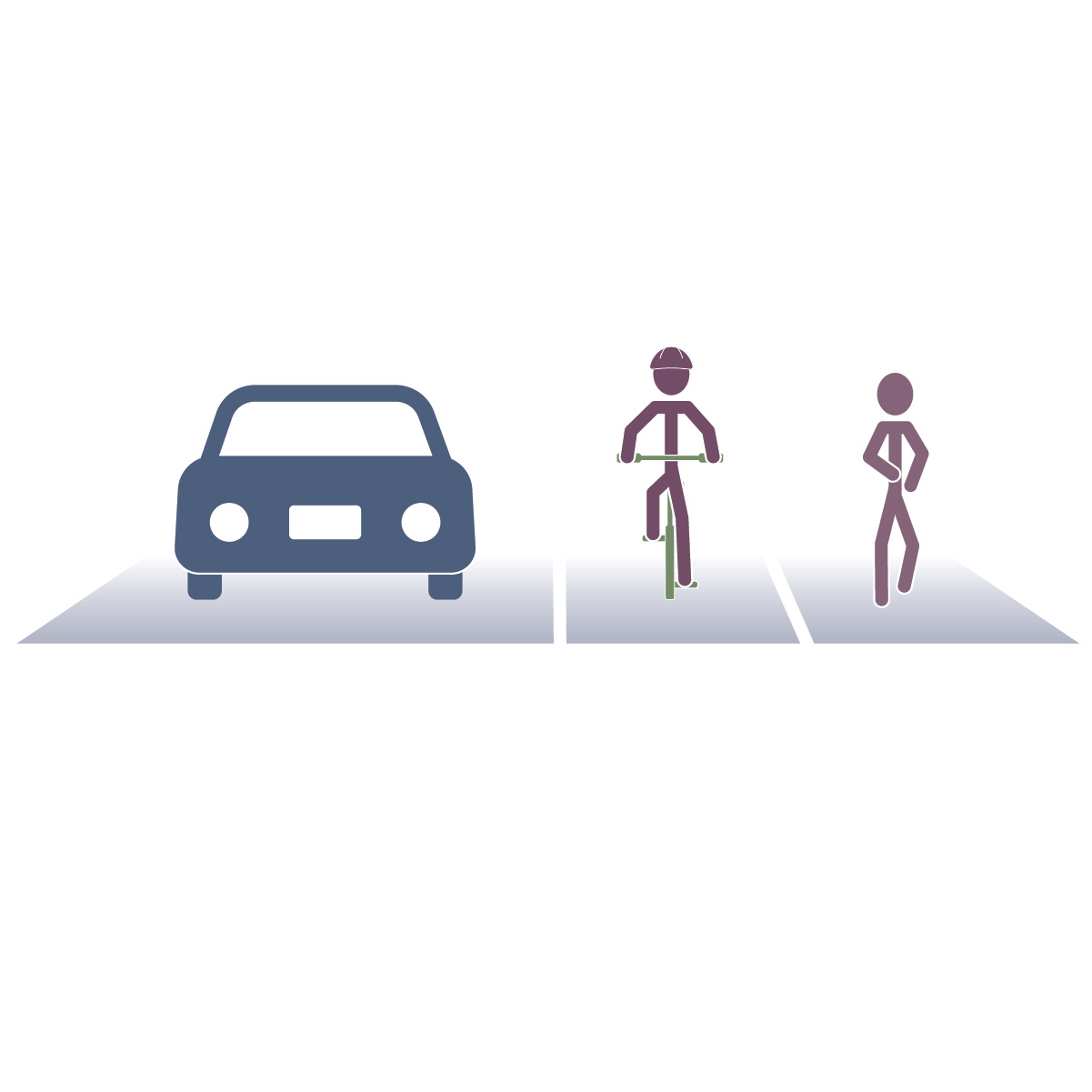
The project will simplify the interchange’s configuration, easing movement for all users and improving safety for our most vulnerable road users.
The complexity and congestion at the I-5 Broadway/Weidler interchange makes it challenging for automobiles, transit, pedestrians, and bicyclists to get around.
Project impacts
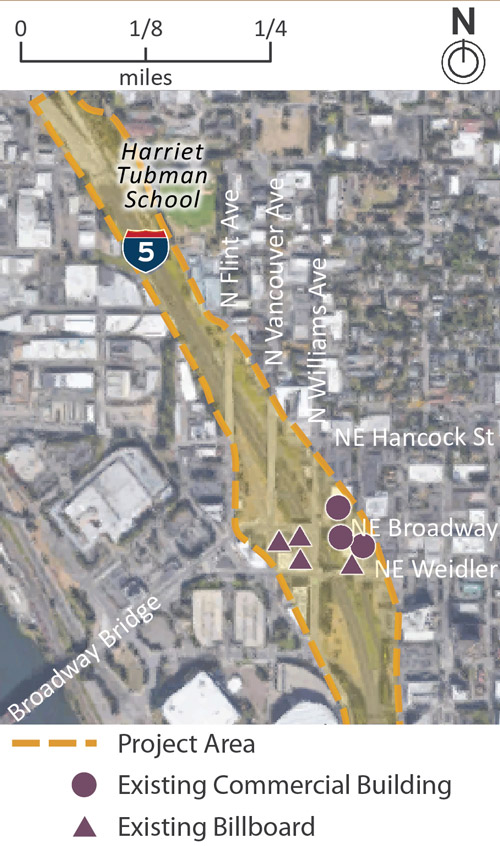
It is our intent to minimize impacts to private property and business. Most of the planned project features, including the auxiliary lanes and shoulders on I-5, are within existing ODOT property (i.e., right-of-way). As a result, the project will impact only a minimal amount of private property. No homes are displaced by the project (see image).
The project will likely need to purchase three commercial buildings and four large billboards near Broadway and Weidler (indicated in purple). Some of the land purchases are needed for temporary construction activities and will be available for future redevelopment supporting economic growth and opportunity once construction is complete. Discussions with property owners are ongoing.
The project’s Environmental Assessment included a specific assessment of highway emissions near the school. The analysis showed that over time, with or without the project, there will be a large decrease in highway emissions because of improved fuel efficiencies in motor vehicles. The difference in emissions between constructing the project and not constructing the project is minimal; however, constructing the project would actually help decrease emissions due to reduced idle time cause by congestion.
The project proposes constructing a sound wall between I-5 and the school that would reduce traffic noise levels to below current levels. We are exploring options for how the sound wall could provide a barrier for air pollutants coming from traffic on I-5. The project also plans to construct a retaining wall between the school and I-5 to improve the soil stability and the safety of the school’s structure in the event of an earthquake.
Project values
Adopted by the Executive Steering Committee on October 26, 2020.
- Restorative Justice. The aim of this value is to advance social and racial equity resulting in positive change.
- Community Input and Transparent Decision-Making. The aim of this value is to have community-informed and involved decision-making through a community-connected, transparent and inclusionary process.
- Mobility Focus. The aim of this value is to increase connectivity for the traveling public and local community.
- Climate Action and Improved Public Health. The aim of this value is to reduce greenhouse gas emissions and meet local, regional, and statewide climate action goals.
Our values in practice
The project is key to reconnecting the Albina community - it will create a foundation above I-5 that provides more community space, makes the area more pedestrian and bike friendly, and provides critical emergency access in the event of a major earthquake.
We need the community’s help to refine how these new highway covers will be used. Your responses to this online open house and future community input and involvement, will help determine future design options such as buildings, spaces, and street environments that provide opportunities for economic development and wealth creation within the Albina community.
We are putting the needs of historically harmed communities first. From previous engagement with African American community members, Native American community members, and other communities of color, the project team has heard how these communities would like to be engaged and will work with these communities to develop engagement strategies. We acknowledge that we need to earn the trust of these communities and commit to centering communities of color.
As engagement continues, the project team will prioritize and focus on the needs of these communities by:
- Establishing the Historic Albina Advisory Board to advise the Executive Steering Committee on project design elements, including the highway covers, as well as future development of the historic Albina neighborhood
- Engaging community-based organizations representing communities of color
- Continuing to hold focus and discussion groups at key milestones with African Americans, Native Americans, and other communities of color
- Continuing to meet with community-based organizations and other key stakeholder groups
- Ensuring that communities of color are represented in the Project’s advisory committees
- Maintaining and publishing an accountability matrix – a document that summarizes feedback from stakeholders and tracks ODOT’s responses/commitments
- Meeting the community where they are and through their trusted mediums or channels
We are committed to doing business differently with minority businesses by providing more contracting and, in turn, workforce opportunities than ever before. We will leverage deep ties with the historic Albina community to ensure meaningful involvement helps shape this project and leads to opportunities beyond the project.
Our top priority is ensuring minorities and women gain the benefit of short-term local workforce trade employment, but also develop their skills through apprenticeships for long-term wealth generation.
Following a competitive bid process, ODOT contracted with Hamilton Sundt, a Joint Venture, in association with Raimore Construction, a Portland-based Black-owned business, as the Construction Manager / General Contractor.
This marks a significant moment for ODOT and the Portland metro region. For the first time in the Portland region, ODOT is bringing the construction manager on board early in the design phase and developing contractor specifications directly informed by community input. Having the Construction Manager / General Contractor on board early in the design process is a key step toward delivering a community-based vision for historic Albina.
Substantial work packages for Disadvantaged Business Enterprise contractors are expected to become available as soon as 2021. ODOT is requiring the construction manager to meet a goal range of 18-22% use of Disadvantaged Business Enterprises. Workforce goals include a 20% goal for apprenticeships, 25% minority male and 14% female workers.
Specific strategies will hold the construction contractor accountable, including small business capacity strengthening, technical assistance and robust performance metrics. A Community Oversight Advisory Committee will help ODOT oversee the construction team, provide accountability and develop a successful program that maximizes Disadvantaged Business Enterprise and local minority and women workers.
Our commitment to reconnecting the Albina community
Past transportation decisions, planning, and construction, often made by ODOT and other public and private entities, have caused harm to many communities, including Albina. At ODOT, we acknowledge our role in this harm and are committed to act toward righting the wrongs of the past. We aim to create a project that is integrated into and champions the vision of a safer, more just and inclusive Albina community and greater Portland Region.
We must ensure participation by the community so that the project directly benefits the Historic Albina community. Partnerships with and support of the Black community are core to the project’s success, and we look forward to deepening that work.
To help us achieve this goal, we are forming a Historic Albina Advisory Board made up members of the community who have ties to the Albina neighborhood. This group will advise us on how to design the project, especially the covers and structures on the covers, that delivers on our promise to reconnect historic Albina.
Learn about our project committees
How we got here
In April 2019, ODOT published an Environmental Assessment (read the Executive Summary), which documented the project’s benefits and impacts. In January 2020, ODOT prepared and released the Cost to Complete report, documenting the approach and plan to deliver the project within a projected cost and schedule. In coordination with the Federal Highway Administraiton, ODOT published the revised Environmental Assessment and the Finding of No Significant Impact on October 30, 2020. This key milestone marks the end of the environmental review process while kicking off a new phase – working with our project partners and the community to design and build a project that provides the most community benefit.
While the project’s general concept is defined, we need the community to shape the project’s design and community benefits and outcomes. The project is in the very early stages of design and there is still a lot of work to be done. Visit the FAQs to learn more.
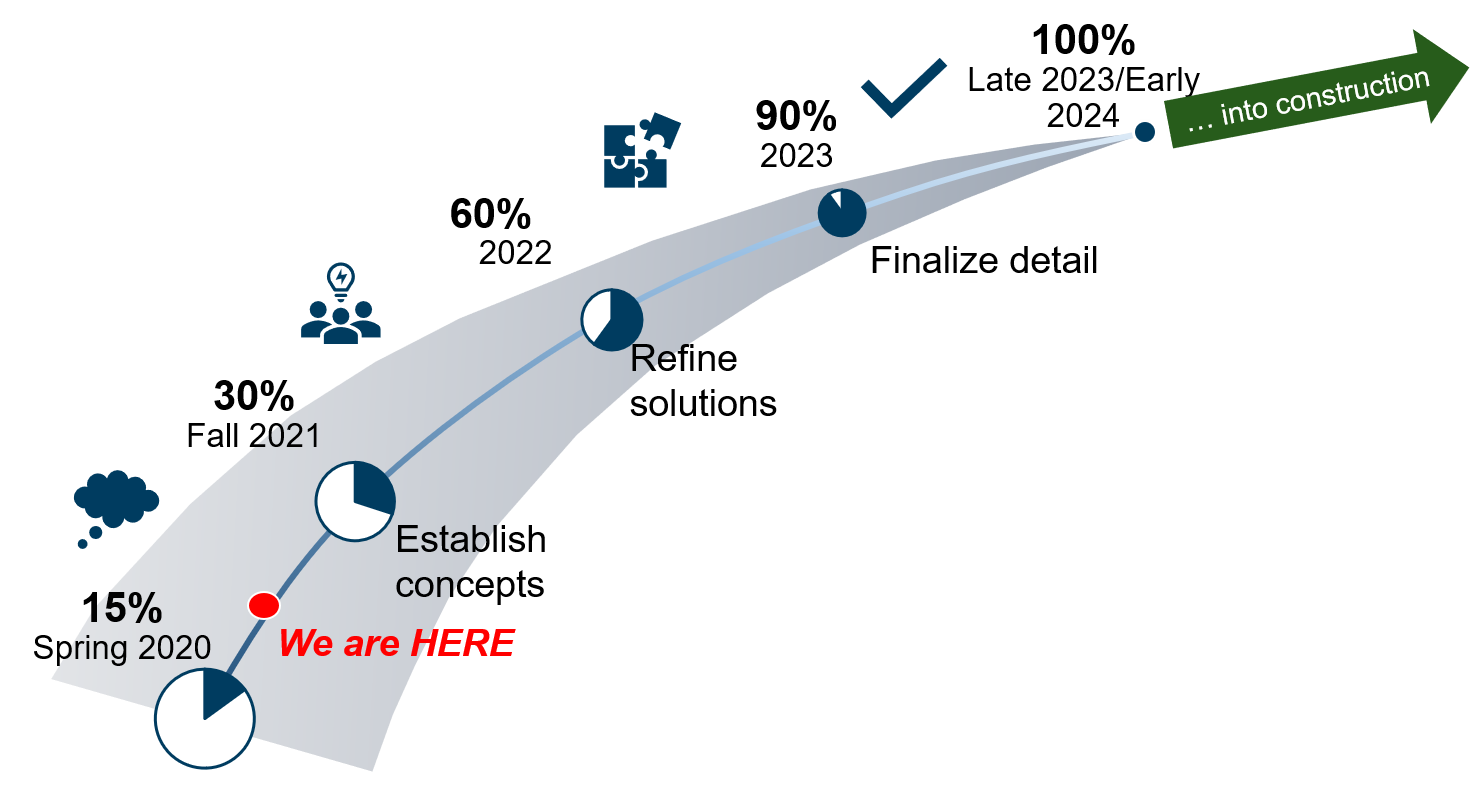
30 Percent Design Milestone
The next major milestone, 30 percent design, will establish major design concepts, such as potential types of uses for the highway covers, possible street and open space uses, and the size shape and location of the Clackamas Pedestrian and Bicycle Crossing.
Feedback from this online open house and other stakeholder engagement will inform uses and design options for the covers that are critical to the 30 percent design milestone. We will also continue public engagement throughout 2021 on these important topics and report back what we have heard and how this input has shaped project decisions.
Environmental Peer Review
In May 2020, an Environmental Peer Review Panel delivered a report evaluating the noise, air quality, and greenhouse gas technical analyses that were conducted for the Environmental Assessment. This was an independent group of national experts on these topics from the public and private sectors. This review was conducted at the request of the public and project partners.
The Panel addressed a set of three questions for each technical analysis assessing the methodology applied, the appropriateness of the analysis, and whether the proposed conclusions and mitigation measures adequately addressed the impacts identified in the analysis.
The Report supported ODOT’s findings for air, greenhouse gas, and noise impacts for the project. It also provided recommendations to incorporate into the project’s future design and construction phases, such as the requirement of low-emission construction equipment including electric vehicles.
Independent Cover Assessment
In response to public and partner feedback, ODOT contracted a third party, ZGF Architects, to complete an independent cover assessment. The purpose of this assessment is to make recommendations to the Oregon Transportation Commission about how ODOT can, within the scope of its authority, design and build a project that promotes the redevelopment of the Albina neighborhood while creating economic opportunities for residents and minority-owned businesses.
We will share more details as this process moves forward, particularly about opportunities for public feedback.
Stay involved
Community input and collaboration is an essential part of this project. There are many decisions ahead and ODOT will be looking to you to help shape the project. We invite and encourage you to get involved!
- Join the project’s email list to get notifications about upcoming events and ways to get involved by visiting i5rosequarter.org/contact/ or emailing info@i5rosequarter.org.
- For more information on the project and past news updates, visit the I-5 Rose Quarter Project Improvement website and read our FAQs.
We appreciate you getting involved, learning with us, and sharing your thoughts and ideas.
Join a committee meeting
The Project’s committees advise the project team on topics such as design and contracting guidelines. View past committee meetings or participate in a future meeting through Zoom.
COVID-19
In response to the Oregon Governor’s Office direction to help slow and prevent the spread of coronavirus (COVID-19), all in-person engagement will be held on virtual platforms until further notice and will remain open to the public. The project team is committed to maintaining accessibility and transparency for all virtual engagement and public meetings. The project team is aware of the technological barriers that virtual engagement and meetings may have on our communities, especially communities of color. The project team will be intentional about addressing barriers to engagement and being culturally responsive by using a racial equity lens and relying on the guidance of our community-based organizations, community leaders, project partners and using best practices.




